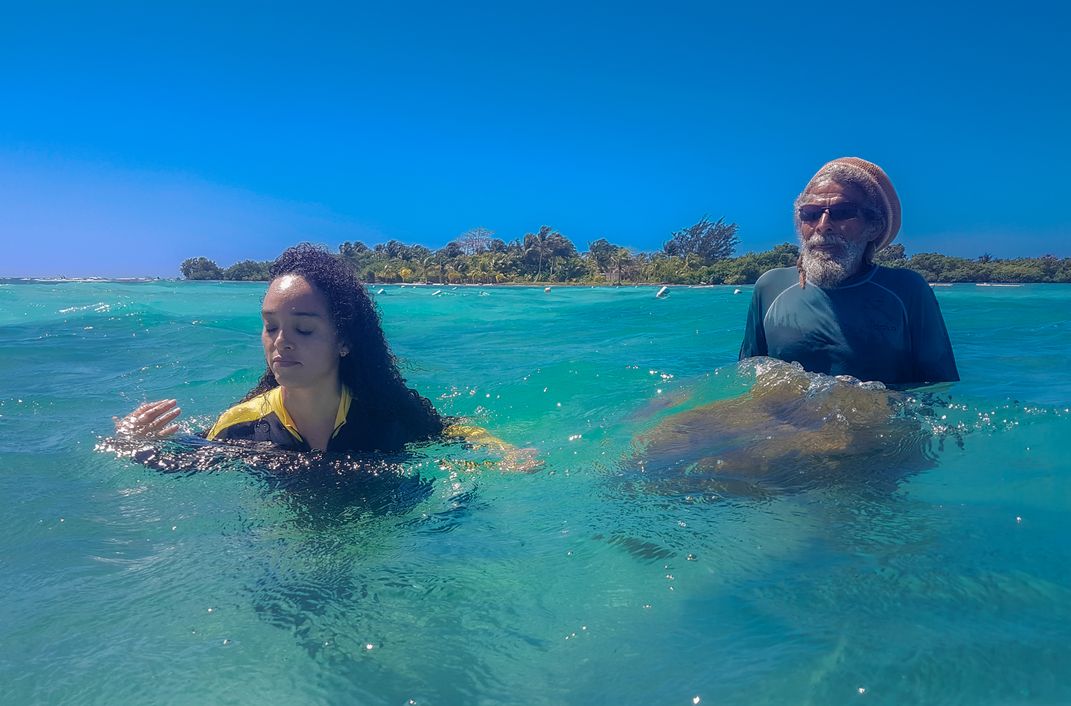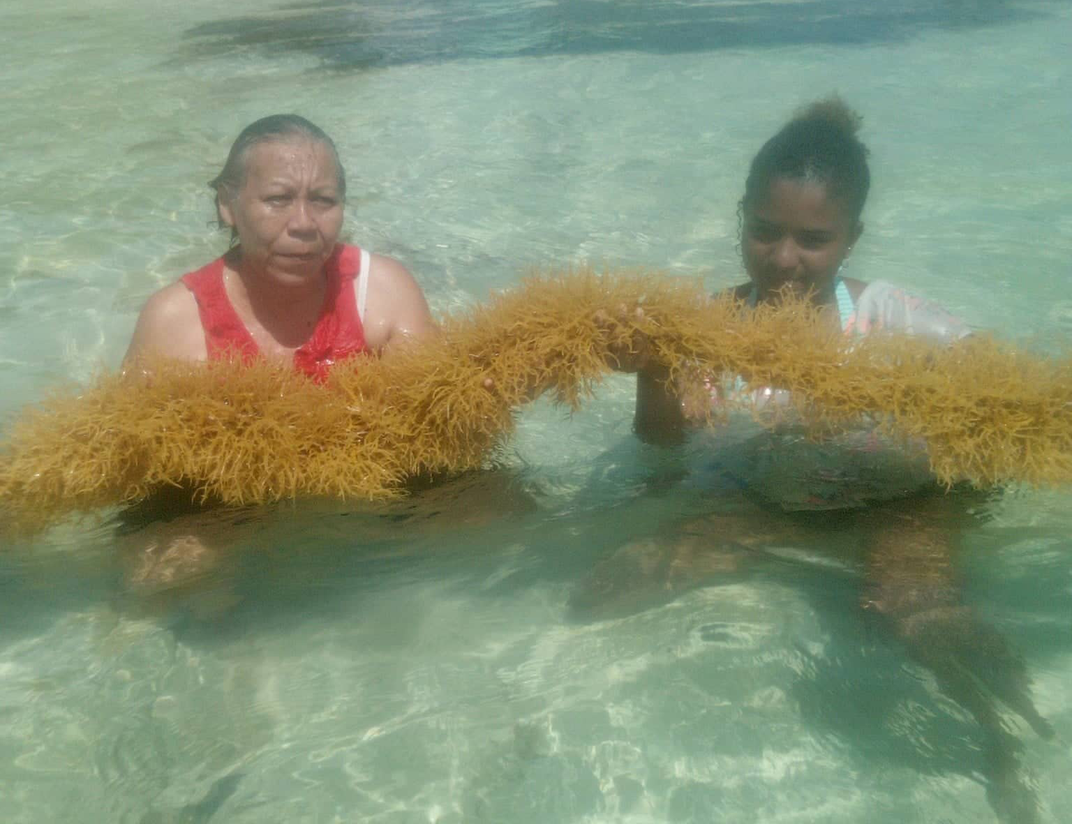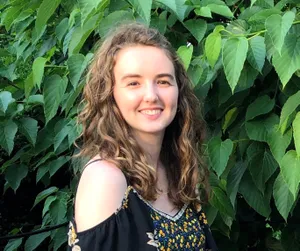Sustaining a Green Business
Belizean eco-entrepreneur Jolie Pollard shares insights into breaking into the green beauty business in this second story of a two-part series.
:focal(2009x1316:2010x1317)/https://tf-cmsv2-smithsonianmag-media.s3.amazonaws.com/blogging/featured/20210227_103642_2.jpg)
Jolie Pollard’s grandfather made the best seaweed shakes in Placencia Village. She never would have guessed that someday she would love using the key ingredient in her hair too.
Many Belizeans that once saw seaweed as a healthy addition to traditional dishes are now recognizing its potential as an environmental and economic solution. The promising seaweed aquaculture industry is helping marine farmers around the world capture carbon, support fish populations, and maintain a sustainable source of income.
In Placencia Village, a fishing community turned eco-tourism destination, seaweed is empowering locals to address challenges that are often beyond their control – from rising costs of living that are displacing Belizeans from their home, to taking care of curly hair while surrounded by humidity and salt water.
Pollard started Ikooma – a kriolized name for the Eucheuma isiforme seaweed that she uses in her natural hair care products – as a creative way to use the seaweed cultivated in her community. Pollard will be bringing samples of seaweed – along with her popular Ikooma products – to the National Mall for the Earth Optimism x Folklife Festival, hoping to introduce the global community to the Belizean specialty.
We met with Pollard over Zoom to learn from her experiences in running a green beauty business. This interview has been edited for length and clarity.
What inspired you to start using seaweed in your hair care products?
Belizean seaweed is among the highest quality in the world, because it grows so far off the coastline that runoff from the mainland can’t affect it. Our seaweed is very clean, very nutritious, so it has a lot of good things to offer.
I knew the value of seaweed for the environment, and I knew that growing seaweed has big potential for our local economy. Lowell “Japs” Godfrey, a pioneer of the seaweed farming industry in this country, always thought this would be a great alternative form of income for the fishing industry and provide local people with a sense of autonomy.
In 2015, I hosted Sarah Aly, a researcher from the Netherlands, in my apartment. Her work connected her to different people who were involved in conservation and the fishing industry, including Japs and the seaweed farm he managed, Placencia Producers Cooperative at Little Water Caye. While she was doing that, we talked about seaweed.
We both just happened to have curly or wavy hair. I love swimming, so I wanted a product that would help my hair in a place where I'm exposed to salt water and humidity. With very limited options around us for natural products that don’t damage our hair, we tried making our own.
One day we had seaweed jelly in the fridge, so we could scoop little spoonfuls into our smoothies. I don’t remember why, but that day we decided to put the jelly in our hair.
We both had an a-ha moment once we realized how nice it felt in our hair, and how great it made us both look! I started adding seaweed to the cream I was working on, and everyone who tried it thought it was really effective. I knew then that seaweed is a game changer for hair.

What challenges have you faced in building your business?
Coming up with sustainable packaging that won’t break the bank for the consumer is a big challenge. The green beauty industry can be very elitist, leaving people in lower economic brackets feeling like they have no option but to be the bad guy and buy the chemical-filled product in the plastic bottle.
I often wonder what we communicate to those people. How does that impact their morale in being engaged in the fight against climate change? I think they feel left out.
It can feel very hypocritical to push an ingredient that is so Earth-friendly when I’m packaging it in plastic, but it’s hard to produce without plastic. I wanted to sell my products in glass instead, but because I live in a remote place where everything has to be shipped by plane, I knew glass would be too expensive and nobody would buy it here.
To address that concern here in Belize, I started using biodegradable pouches that customers can order for refills. It’s a plastic reduction tactic, not yet an elimination tactic. For the Folklife Festival, I got some glass jars, but to meet FDA requirements, I needed to have a sealed plastic lid. I had to compromise, which was really hard, but it was the best I could do at the moment.
I know that there are a lot of companies in the world right now looking at seaweed as a bioplastic material. It would be my ultimate dream to have a seaweed product inside a seaweed product! I’ve actually contacted a few of them to see if they have any bottles or jars, but the challenge is making them sturdy and durable enough to transport liquids or soft ingredients.
Consumers are becoming more and more choosy about what’s in the products they buy. What sets the sustainable beauty market apart?
Green and sustainable beauty sells a lot more than just natural ingredients. It sells stories, it sells ethics, and it helps to protect the people behind the brand.
It takes a lot of people to make a product. It’s a relationship among the person producing the product, the people providing the raw materials, and the conscious consumer that supports us. I have an advantage with my brand in that I’m producing it here in my community, where I know their story.
I take a lot of pride knowing that I buy seaweed directly from the farmers, and pay them exactly what they charge. Of course, I believe they may be willing to work with me on prices, but as another small business owner, I understand how difficult it can be. I’m not going to make myself more comfortable at their expense

What advice do you have for another aspiring eco-entrepreneur?
Just be honest with your consumers. Transparency sells! Today, it’s really hard to get away with lying to the consumer – they will dig it up and find out whether you’re being honest.
A lot of eco-entrepreneurs are people who genuinely care about the planet. I think a lot of those people struggle with feeling like we have to be perfect. I know that brought me down in the beginning. It made me wonder – should I even be doing this?
It’s hard, but you’re going to have to tell yourself that you’re trying, you’re making an effort. Just remember that a lot of other companies aren’t even considering any of these things. For me, I’m buying plastic containers, but I have biodegradable refill pouches, so that’s one less bottle that someone may have just used and thrown out.
You're gonna have to make money, obviously, to sustain your business. As you grow, you'll find yourself having more of the resources and the power to improve your product.
Running a small business can be difficult – especially when you’re trying to keep it green! What gives you the optimism to keep going?
My favorite thing about what I do is the confidence that it gives my consumers. Sometimes, when I start feeling a little deflated by my struggles, a customer tells me how wonderful my product is – how it's the best thing they've used, how much it's helped their hair, how they struggle to find anything that worked for them, how they feel so glad to have something that could work on their children. Or I hear that some kid who struggled with her curls feels so much better about herself and her curls now.
That encourages me because I can get trapped in these other things and forget that I'm making a product that people like and put in their hair and they really like. It brings me back to why I was doing this in the first place – because I wanted a good product for my own hair. As they say, you have to know your “why,” and you gotta keep traveling back to your “why” when you get lost along the way.
What are you most excited to share at the Folklife Festival?
Having lived in the United States, I know that there are a lot of different seaweed on the market, like kelp in beauty products or the seaweed that you’d eat in sushi. I am sure that there will be a lot of people who haven’t heard of Eucheuma isiforme, which is the species that I use in my products!
I’m excited to show them what it looks like and the benefits that it can offer – both as a business owner that uses them in my own product, but also as a member of a community that could really benefit from its economic potential without compromising our local environment.
We’re all looking for solutions without feeling like we have to deprive ourselves. I think that’s a big challenge with climate change – people feel like they can do better, but they don’t want to deprive themselves of something good. I think that seaweed answers that in a lot of ways. We can make money, we can produce stuff, we can have manufacturing, but at the same time, we’re not harming the environment. We can do it all better.

